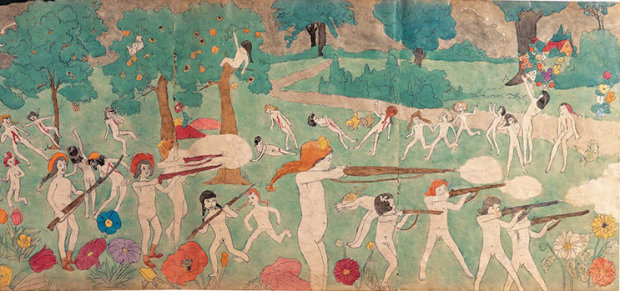
Henry Darger’s Body of Art - ‘Magnificently lyrical’
The transgender children in this canonical work of outsider art are another highlight from our new book Body of Art
Next week Phaidon and Artspace will begin bringing you a series of interviews with artists, curators, academics, institute directors and other prominent figures, all on and around the subject of our brilliant new book Body of Art. This title is the first to celebrate the beautiful and provocative ways artists have represented, scrutinised and utilised the body over the centuries. You can read an introduction here to gain some insight into the themes they will be focusing on. As you may know, this week we're posting a story a day to whet your appetite. You can read about works by George Condo, Paul McCarthy, and Fernand Léger.
Today we’re looking at Henry Darger’s epic 20th century work of outsider art In the Realms of the Unreal. This extraordinary illustrated fantasy tale, which went unpublished during Darger’s lifetime, remains one of the most beautifully conceived, and psychologically disturbing 20th century manuscripts, not least for its depiction of pre-pubescent girls.
“When Henry Darger died in 1973 he left behind a lifetime of work in his one-bedroom Chicago apartment. Darger, who had worked as a janitor in a hospital for most of his adult life, was a man immersed in his own radical imagination. In isolation he laboured at a 5,000-page manuscript titled The History of My Life; kept a journal that fastidiously tracked weather conditions over a ten-year period; and, most significantly, created a fantastical 15,145-page illustrated tale, In the Realms of the Unreal.
The heroines of this epic story are the Vivian Girls – seven child princesses and sisters fighting in a conflict that was inspired, in part, by news reports, the American Civil War and Darger’s personal life. The girls’ evil enemies, the Glandelinians, are adults who enslave, gruesomely torture and massacre children. Darger, who had suffered a traumatic childhood, wrote himself into the story as the children’s protector. Subject to many interpretations and much debate is his depiction of children as transgendered, often showing young girls naked with prepubescent penises. Blending watercolour, magazine cut-outs, Catholic references and other imagery, his pictures can be both disturbing and magnificently lyrical. Preceding late-twentieth century movements such as Pop art but at the same time defying categories, Darger’s art is brimming with vibrant obsessions and imaginative totality."
Check back tomorrow for another teaser from Body of Art. You can also learn more about the book here, and pre-order your copy here.